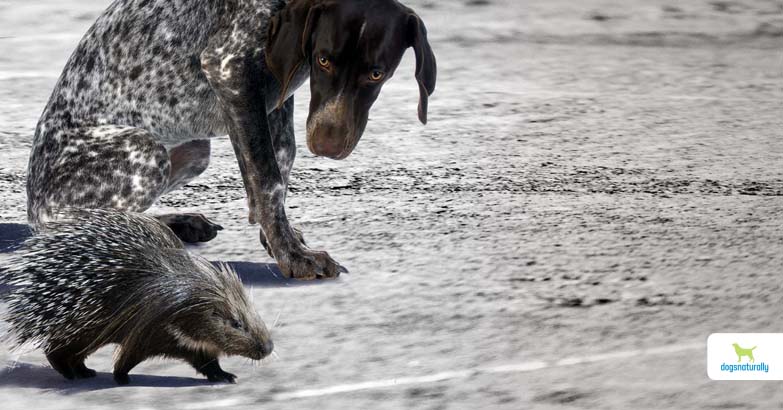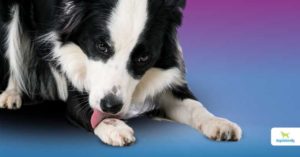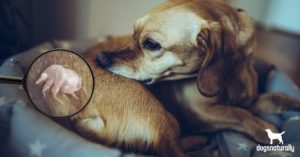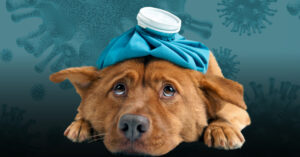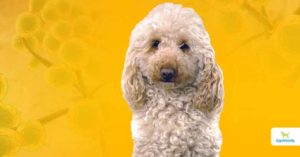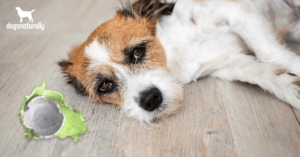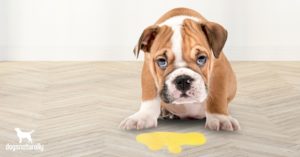If your dog smells a wild animal, he’ll want to investigate. And that doesn’t always end well. Especially if you live somewhere your dog might meet a porcupine.
Porcupines are large rodents that live in a many rural areas in North America. If your dog investigates a porcupine too closely, your dog may get a face full of quills. Read on to find out how that happens and what to do for a dog with porcupine quills.
What Are Porcupine Quills Made Of?
Quills are hairs that are coated with the protein keratin. This makes them them hard and sharp. Each porcupine has about 30,000 quills over his body and tail – that’s more than 100 quills per square inch. The quills have little barbs that grab onto whatever they touch.
How Quills Get In Your Dog
Porcupines use scent marking to communicate … and that scent is what attracts your dog to check out the porcupine. Like a skunk, the porcupine will use scent to deter a predator. He may also clack his teeth in warning. But the quills may be next, if your dog gets too close.
It’s a common misconception that porcupines shoot out their quills. But it’s really a more passive process. What actually happens is that the quills release when they come into contact with something. The little barbs make the quills stick to whatever they’ve touched, and if that’s your dog, they’ll penetrate his skin. The quills are painful and difficult to remove.
The worst quills are the ones on his tail and rump, because they’re longer than the ones on the rest of his body. And when porcupines are afraid, they’ll turn their tail towards the predator and raise their tails.
Risks Of Porcupine Quills
Porcupine quills can be quite painful to your dog. And as he moves around, the quills work themselves deeper into his body. If quills get deeply embedded and aren’t promptly removed, they can migrate and even puncture your dog’s veins or organs. They may also carry bacteria than can cause infection or abscesses in your dog. However, porcupine quills aren’t poisonous and don’t transmit disease.
But you need to remove them promptly … whether you ask a vet to do it or you tackle it yourself.
What To Do For Porcupine Quills In Dogs
The first thing to do is get your dog far away from the porcupine to avoid another incident. Next …
- Try to keep your dog as calm and still as possible
- Stop your dog from rubbing or pawing at the quills, which will only embed them deeper
- Check to see where your dog has quills (If they’re in sensitive areas, a vet visit is best)
- Avoid touching the quills yourself until you’re home
Will Porcupine Quills Work Their Way Out?
No, they won’t. The barb will keep them attached to your dog’s skin, and as he moves around, they’ll become more deeply embedded. They can cause infection, migrate to other parts of the body (like the eyes or other organs), and cause serious health problems. So you must act to remove the quills as soon as possible.
Should You Cut The Quills?
No, don’t cut the quills. Some people think that if you cut the end off the quill, it will be easier to pull out. But cutting the quills makes them more likely to splinter and be harder to remove.
Should You Remove The Quills Yourself?
Most experts urge you to take your dog to the vet to have the quills removed, especially if there are a lot of quills. It can be a slow and painful process, and some dogs will need to be sedated and even get pain medication.
But if you’re brave and patient, or you’re somewhere remote, and you want to try to do it yourself … be very careful. Your dog may get agitated and struggle or even bite.
Before you decide, gently check over your dog’s body. If there are quills embedded in any sensitive areas, like inside your dog’s mouth, you’ll definitely need your vet’s help. If your dog’s fussing and wriggling, it’s also best to go to the vet. Removing them will be more painful if you can’t keep him still.
Otherwise, here’s what to do … but no matter what you decide, you’ll need to act quickly.
How To Remove Porcupine Quills From Your Dog
Use a tool like needle-nose pliers to grip the porcupine quills. Get a firm hold and gently pull them out. Even so, this will be painful for your dog. Try not to break the quills. Broken quills are more difficult to remove, as are deep quills. Be very careful not to break the quills and leave pieces in the skin. They can splinter and cause infection and abscesses.
Natural Remedies For Quill Removal
There are a few homeopathic remedies can help you get the quills out and help the wounds heal.
Silica (or Silicea) is a remedy that helps to expel foreign bodies. Use a 30C or 6C potency and give your dog 2-3 pellets (straight in the mouth, away from food and without touching the pellets with your hands) 3 times daily, until the quills or leftover pieces come to the skin”s surface. (Silica is also great to help get rid of splinters or foxtails.)
Ledum (Ledum palustre) works well to heal puncture wounds. Choose a 30C or 200C potency, and dose 2-3 pelletes a couple of times a day until the wounds start healing. You can stop dosing once you see them starting to heal. (Ledum is also a good remedy for insect bites or stings, including to prevent Lyme disease from tick bites. .
If quills are properly removed, the risk of infection appears fairly low. A review of dogs with porcupine quills by the University of Saskatchewan found that giving antibiotics didn’t affect the rate of complications after quill removal.
But ir you do notice signs of infection of abscess, the remedy Hepar sulphuris will help resolve it. Use a 30C potency and give 2-3 pellets e times a day until you notice an improvement. Again, once healing starts, you can stop dosing.
If your dog’s in pain, you can give herbal remedies like CBD Oil or other herbal pain killers.
RELATED: What do do when your dog gets sprayed by a skunk …
When To Go To The Vet For Porcupine Quills
If your dog is won’t keep still, or he’s covered in a lot of quills or has quills in his mouth or nose or other sensitive places, then it’s best to get veterinary care.
He may need to be sedated and even stay overnight or have a second visit to get all the quills removed.
And of course, if you remove the quills yourself but you aren’t sure you’ve done a thorough job, you may want to have your vet check him over afterwards, to be safe.
Of course, it’s best to avoid porcupine encounters in the first place!
How To Avoid Porcupines
Avoidance is the best strategy when it comes to porcupines. So keep a close eye and a leash on your dog when you’re in unfamiliar surroundings.
Porcupines tend to be most active around dusk or dawn in wooded areas, especially during the summer so avoid letting your dog off-leash at those times.
Many dog owners and vets report that dogs don’t learn from their mistakes when it comes to porcupines. So even iv your dog’s been “quilled” before, he’ll probably want to investigate the next porcupine he meets.
References
Reference
Johnson, Matthew D et al. “Porcupine quill injuries in dogs: a retrospective of 296 cases (1998-2002).” The Canadian Veterinary Journal = La revue veterinaire canadienne . Vol 47,7 (2006): 677-82.

